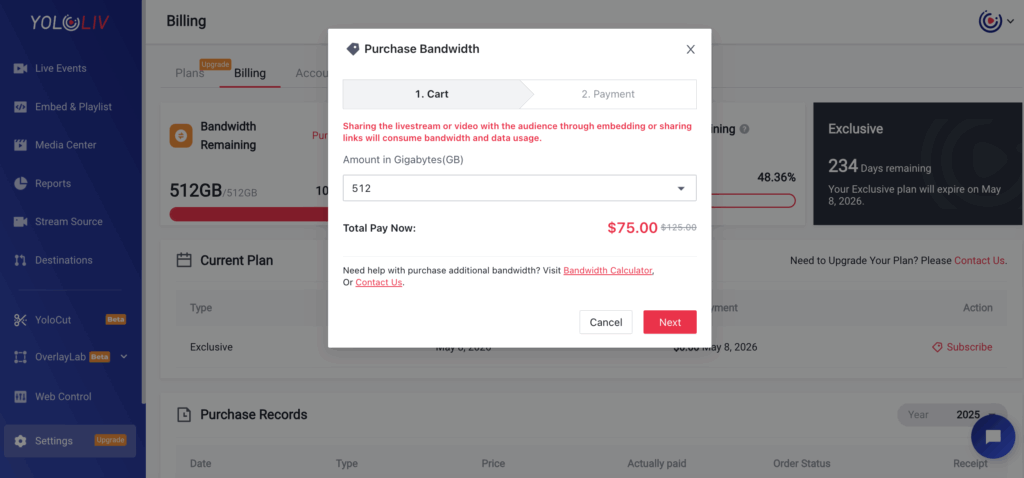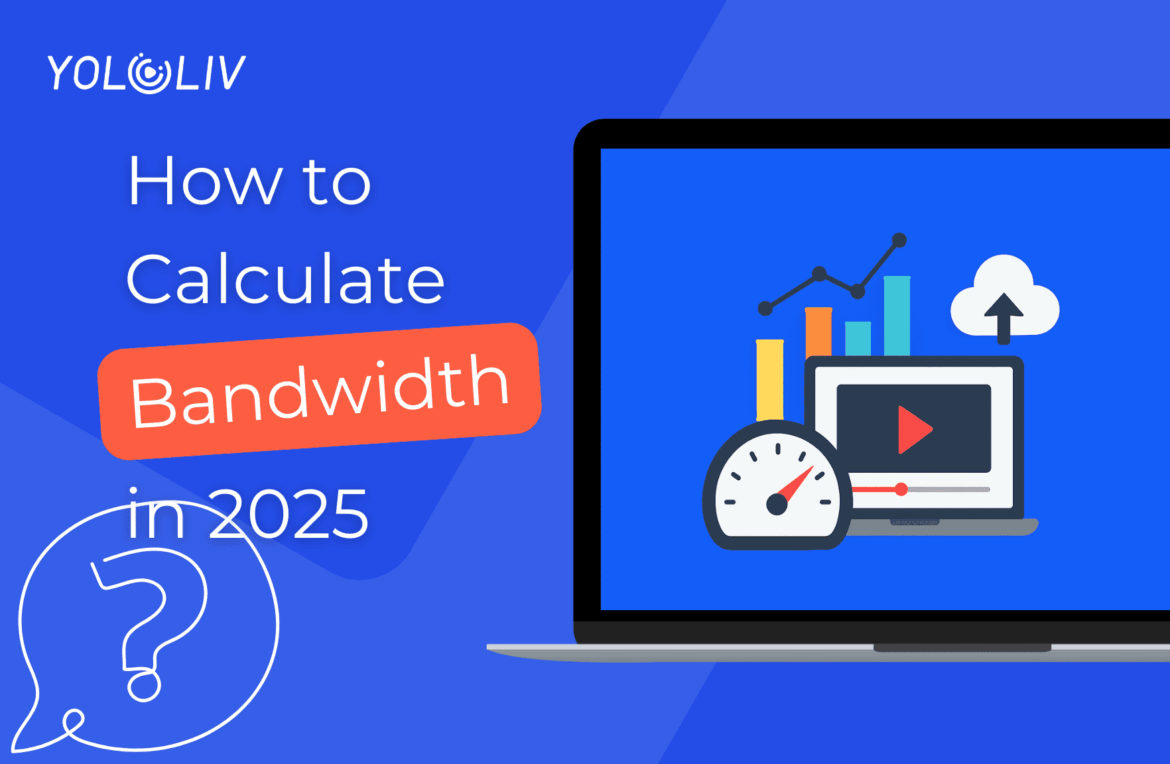When it comes to live streaming in 2025, bandwidth is the backbone of your viewer’s experience. Whether you’re hosting a corporate event, streaming a sports game, or embedding a live concert on your website, understanding how bandwidth works helps you optimize both performance and costs. This guide breaks down everything you need to know about bandwidth calculations, specifically for YoloCast users, so you can stream with confidence.
What is Video Bandwidth?
Video bandwidth is the amount of data that moves through the internet each second. It is measured in megabits per second (Mbps). In live streaming, this number matters a lot. It decides how smooth your video looks and how much you will pay for streaming.
There are two main types of bandwidth:
- Upload bandwidth is what you use to send your video from your camera or encoder to the cloud. If your upload speed is too low, your stream may stop before it reaches your viewers.
- Download bandwidth is what your viewers use to watch your video. If their internet is slow, or if their ISP limits video traffic, they may see buffering, poor quality, or even no playback.
What is YoloCast Bandwidth?
On YoloCast, bandwidth in your plan always means download bandwidth. YoloCast covers the cost of upload bandwidth, so it does not count against your plan.
Here are the main ways download bandwidth is used on YoloCast:
- When you share your event or video link with viewers.
- When you embed your event on your website for people to watch.
But if you multistream to platforms like YouTube or Facebook, that does not use your package bandwidth. YoloCast takes care of that for you.
To put it simply: focus on download bandwidth when planning your live streams. That is what really affects your audience and your costs.
Key Factors That Affect Bandwidth Consumption
Bandwidth use depends on a few important things. If you know these, you can better plan your live streams and avoid surprises.
1. Bitrate
Bitrate means how much video data is sent each second. A higher bitrate gives better quality, but it also uses more bandwidth. For example, a 1080p video at 5 Mbps will use much more bandwidth than a 720p video at 2 Mbps.
2. Frame Rate
Frame rate is how many images (frames) you see every second. A normal stream is 30 fps. Sports or fast-moving events may need 60 fps or more. More frames mean more data, and that means more bandwidth.
3. Latency
Latency is the delay between when the video is captured and when viewers see it. Latency does not change bandwidth use directly, but low-latency streaming needs faster, smarter delivery. If latency is too high, interaction feels broken.
4. Throughput
Throughput is the actual data that makes it to the viewer. You can think of it as “real usable bandwidth.” Even if you set a high bitrate, if a viewer’s throughput is too low, they will still see buffering or low quality. YoloCast solves this with multiple CDNs and edge servers, so viewers get the video from the closest location.
How to Calculate Bandwidth Usage for Streaming
Here’s a simple formula:
Bandwidth (GB) = Bitrate (Mbps) × Duration (Seconds) × Viewers ÷ 8 ÷ 1024
- Bitrate = how much data per second (set by YoloCast).
- Duration = how long the stream lasts.
- Viewers = how many people are watching.
- ÷ 8 = convert bits to bytes.
- ÷ 1024 = convert MB to GB.
Example:
A 30-minute live stream (1,800 seconds) at 4 Mbps with 20 viewers:
4 × 1,800 × 20 ÷ 8 ÷ 1024 ≈ 451 GB of bandwidth.YoloCast also gives you a free tool to make this easier: Bandwidth Calculator. You just enter your stream length, bitrate, and audience size, and it shows you how much you’ll need.
YoloCast Bandwidth Plans
YoloCast offers four main plans. Each includes a set amount of bandwidth per month:
| Plan | Price/Month | Included Bandwidth |
| Starter | $29 | No bandwidth included |
| Exclusive | $49 | 512 GB / month |
| Professional | $89 | 1 TB / month |
| Business | $119 | 2 TB / month |
If you need more, you can buy extra bandwidth at $75 for 512 GB directly from your billing page.
This way, you only pay for what you need.
Conclusion
Bandwidth is the fuel of live streaming. If you don’t plan for it, your viewers may face buffering, low quality, or even failed streams. But with the right calculations, you can avoid problems and keep costs under control.
On YoloCast, remember these key points:
- Bandwidth in your plan means download bandwidth only.
- Upload costs are covered by YoloCast.
- Multistreaming to YouTube or Facebook does not use your package bandwidth.
- Use the calculator to plan ahead and choose the best plan for your needs.
With this knowledge, you can stream with confidence, knowing your audience will enjoy smooth playback and you will stay within budget.
FAQ
1. What if I go over my bandwidth limit on YoloCast?
You can buy extra bandwidth on YoloCast billing page:https://dashboard.yololiv.com/settings/billing

2. Does multistreaming use my YoloCast bandwidth?
No. Streaming to YouTube, Facebook, or other platforms does not consume the bandwidth included in your package.
3. Which plan should I pick?
It depends on your streaming needs. You can visit our Compare Plans page to see the features and bandwidth included in each plan, and choose the one that best fits your requirements.
5,855 total views, 99 views today

Hailey, a Customer Success Specialist at Yololiv, she brings immense enthusiasm to assisting users in understanding the various features of YoloCast and resolving any usage-related issues they may encounter. Alongside her support efforts, she also curates articles sharing tips, troubleshooting advice, and other helpful insights to enhance users’ experience with YoloCast.


